Tribocorrosion Failure Mechanism of TiN/SiOx Duplex Coating Deposited on AISI304 Stainless Steel
Abstract
:1. Introduction
2. Materials and Methods
3. Results and Discussion
4. Conclusions
- (1).
- The TiN/SiOx duplex coating has a two-layered columnar growth structure which is made up of a face-centered cubic TiN interlayer and a layer of amorphous SiOx, and provides excellent corrosion protection to the stainless steel substrate.
- (2).
- The TiN interlayer exhibits good adhesion with the substrate, but the SiOx layer suffers from severe delamination failure during the sliding test in air.
- (3).
- Frictional force induces a large number of micro-cracks in the TiN/SiOx duplex coating. These micro-cracks provide diffusion channels for the NaCl solution and eventually cause simultaneous chloride ion corrosion during the tribocorrosion.
- (4).
- The multi-scale Cl ion corrosion greatly weakens the bonding strength of the columnar crystals or the adjacent layers. The force-corrosion synergy interaction damage induces multi-degradation failures in the TiN/SiOx duplex coating.
Acknowledgments
Author Contributions
Conflicts of Interest
References
- Jin, Z.H.; Ge, H.H.; Lin, W.W.; Zong, Y.W.; Liu, S.J.; Shi, J.M. Corrosion behaviour of 316L stainless steel and anti-corrosion materials in a high acidified chloride solution. Appl. Surf. Sci. 2014, 322, 47–56. [Google Scholar] [CrossRef]
- Naghizadeh, M.; Nakhaie, D.; Zakeri, M.; Moayed, M.H. The effect of dichromate ion on the pitting corrosion of AISI 316 stainless steel Part II: Pit initiation and transition to stability. Corros. Sci. 2015, 94, 420–427. [Google Scholar] [CrossRef]
- Pacquentin, W.; Carona, N.; Oltra, R. Effect of microstructure and chemical composition on localized corrosion resistance of a AISI 304L stainless steel after nanopulsed-laser surface melting. Appl. Surf. Sci. 2015, 356, 561–573. [Google Scholar] [CrossRef]
- Von der Ohe, C.B.; Johnsen, R.; Espallargas, N. Multi-degradation behavior of austenitic and super duplex stainless steel—The effect of 4-point static and cyclic bending applied to a simulated seawater tribocorrosion system. Wear 2012, 288, 39–53. [Google Scholar] [CrossRef]
- Sun, Y.; Rana, V. Tribocorrosion behaviour of AISI 304 stainless steel in 0.5 M NaCl solution. Mater. Chem. Phys. 2011, 129, 138–147. [Google Scholar] [CrossRef]
- Silva, R.C.C.; Nogueira, R.P.; Bastos, I.N. Tribocorrosion of UNS S32750 in chloride medium: Effect of the load level. Electrochim. Acta 2011, 56, 8839–8845. [Google Scholar] [CrossRef]
- López, A.; Bayón, R.; Pagano, F.; Igartua, A.; Arredondo, A.; Arana, J.L.; González, J.J. Tribocorrosion behaviour of mooring high strength low alloy steels in synthetic seawater. Wear 2015, 338–339, 1–10. [Google Scholar] [CrossRef]
- Ye, Y.W.; Wang, Y.X.; Wang, C.T.; Li, J.L.; Yao, Y.R. An analysis on tribological performance of CrCN coatings with different carbon contents in seawater. Tribol. Int. 2015, 91, 131–139. [Google Scholar] [CrossRef]
- Wang, Y.; Northwood, D.O. Effect of substrate material on the corrosion of TiN-coated stainless steels in simulated anode and cathode environments of proton exchange membrane fuel cells. J. Power Sources 2009, 191, 483–488. [Google Scholar] [CrossRef]
- Wang, L.; Su, J.F.; Nie, X. Corrosion and tribological properties and impact fatigue behaviors of TiN- and DLC-coated stainless steels in a simulated body fluid environment. Surf. Coat. Technol. 2010, 205, 1599–1605. [Google Scholar] [CrossRef]
- Sun, T.; Wang, L.P.; Wang, M. Characteristics and mechanical properties of a (Ti, O, N)/Ti composite coating fabricated on NiTi shape memory alloy via PIIID. Mater. Lett. 2010, 64, 1769–1771. [Google Scholar] [CrossRef]
- Kuo, Y.L.; Chang, K.H. Atmospheric pressure plasma enhanced chemical vapor deposition of SiOx films for improved corrosion resistant properties of AZ31 magnesium alloys. Surf. Coat. Technol. 2015, 283, 194–200. [Google Scholar] [CrossRef]
- Gracia-Escosa, E.; García, I.; Sánchez-López, J.C.; Abad, M.D.; Mariscal, A.; Arenas, M.A.; de Damborenea, J.; Conde, A. Tribocorrosion behavior of TiBxCy/a-C nanocomposite coating in strong oxidant disinfectant solutions. Surf. Coat. Technol. 2015, 263, 78–85. [Google Scholar] [CrossRef]
- Shan, L.; Wang, Y.X.; Li, J.L.; Jiang, X.; Chen, J.M. Improving tribological performance of CrN coatings in seawater by structure design. Tribol. Int. 2015, 82, 78–88. [Google Scholar] [CrossRef]
- Rossi, S.; Fedrizzi, L.; Leoni, M.; Scardi, P.; Massiani, Y. (Ti, Cr)N and Ti/TiN PVD coatings on 304 stainless steel substrates: Wear-corrosion behavior. Thin Solid Films 1999, 350, 161–167. [Google Scholar] [CrossRef]
- Naghibi, S.A.; Raeissi, K.; Fathi, M.H. Corrosion and tribocorrosion behavior of Ti/TiN PVD coating on 316L stainless steel substrate in Ringer’s solution. Mater. Chem. Phys. 2014, 148, 614–623. [Google Scholar] [CrossRef]
- Sun, T.; Xue, N.; Liu, C.; Wang, C.; He, J. Bioactive (Si, O, N)/(Ti, O, N)/Ti composite coating on NiTi shapememory alloy for enhanced wear and corrosion performance. Appl. Surf. Sci. 2015, 356, 599–609. [Google Scholar] [CrossRef]
- Lemaire, E.; le Calvar, M. Evidence of tribocorrosion wear in pressurized water reactors. Wear 2001, 249, 338–344. [Google Scholar] [CrossRef]
- Mischler, S. Triboelectrochemical techniques and interpretation methods in tribocorrosion: A comparative evaluation. Tribol. Int. 2008, 41, 573–583. [Google Scholar] [CrossRef]
- Sun, Y.; Bailey, R. Improvement in tribocorrosion behavior of 304 stainless steel by surface mechanical attrition treatment. Surf. Coat. Technol. 2014, 253, 284–291. [Google Scholar] [CrossRef]
- Kok, Y.N.; Akid, R.; Hovsepian, P.E. Tribocorrosion testing of stainless steel (SS) and PVD coated SS using a modified scanning reference electrode technique. Wear 2005, 259, 1472–1481. [Google Scholar] [CrossRef]
- Landolt, D.; Mischler, S.; Stemp, M. Electrochemical methods in tribocorrosion: A critical appraisal. Electrochim. Acta 2001, 46, 3913–3929. [Google Scholar] [CrossRef]
- Yao, Y.R.; Li, J.L.; Wang, Y.X.; Ye, Y.W.; Zhu, L.H. Influence of the negative bias in ion plating on the microstructural and tribological performances of Ti-Si-N coatings in seawater. Surf. Coat. Technol. 2015, 280, 154–162. [Google Scholar] [CrossRef]
- Shan, L.; Wang, Y.X.; Li, J.L.; Li, H.; Wu, X.D.; Chen, J.M. Tribological behaviours of PVD TiN and TiCN coatings in artificial seawater. Surf. Coat. Technol. 2013, 226, 40–50. [Google Scholar] [CrossRef]
- Wang, L.P.; Huang, L.; Xie, Z.W.; Wang, X.F.; Tang, B.Y. Fourth-generation plasma immersion ion implantation and deposition facility for hybrid surface modification layer fabrication. Rev. Sci. Instrum. 2008, 79, 023306. [Google Scholar] [CrossRef] [PubMed]
- Xie, Z.W.; Chen, Q.; Chen, T.; Gao, X.; Yu, X.G.; Song, H.; Feng, Y.J. Microstructure and properties of nitrogen ion implantation/AlN/CrAlN/MoS2-phenolic resin duplex coatings on magnesium alloys. Mater. Chem. Phys. 2015, 160, 212–220. [Google Scholar] [CrossRef]
- Chen, T.; Xie, Z.W.; Gong, F.; Luo, Z.Z.; Yang, Z. Correlation between microstructure evolution and high temperature properties of TiAlSiN hard coatings with different Si and Al content. Appl. Surf. Sci. 2014, 314, 735–745. [Google Scholar] [CrossRef]
- Oliver, W.C.; Pharr, G.M. An improved technique for determining hardness and elastic modulus using load and displacement sensing indentation experiments. J. Mater. Res. 1992, 7, 1564–1583. [Google Scholar] [CrossRef]
- Chen, L.; Du, Y.; Mayrhofer, P.H.; Wang, S.Q.; Li, J. The influence of age-hardening on turning and milling performance of Ti-Al-N coated inserts. Surf. Coat. Technol. 2008, 202, 5158–5161. [Google Scholar] [CrossRef]
- Yu, D.H.; Wang, C.Y.; Cheng, X.L.; Zhang, F.L. Microstructure and properties of TiAlSiN coatings prepared by hybrid PVD technology. Thin Solid Films 2009, 517, 4950–4955. [Google Scholar] [CrossRef]
- Liu, Z.; Ma, X.X.; Yang, C.L.; Xu, F.J. Characterization of composite SiOx/polymer films deposited on pet substrates by RF reactive magnetron sputtering. Vacuum 2013, 89, 109–112. [Google Scholar] [CrossRef]
- Leyland, A.; Matthews, A. On the significance of the H/E ratio in wear control: Ananocomposite coating approach to optimised tribological behavior. Wear 2000, 246, 1–11. [Google Scholar] [CrossRef]
- Lin, J.L.; Moore, J.J.; Mishra, B.; Pinkas, M.; Sproul, W.D. The structure and mechanical and tribological properties of TiBCN nanocomposite coatings. Acta Mater. 2010, 58, 1554–1564. [Google Scholar] [CrossRef]
- Wang, Y.F.; Cheng, G.X.; Wu, W.; Qiao, Q.; Li, Y.; Li, X.F. Effect of pH and chloride on the micro-mechanism of pitting corrosion for high strength pipeline steel in aerated NaCl solutions. Appl. Surf. Sci. 2015, 349, 746–756. [Google Scholar] [CrossRef]
- Bhandari, J.; Khan, F.; Abbassi, R.; Garaniy, V.; Ojeda, R. Modelling of pitting corrosion in marine and off shore steel structures-A technical review. J. Loss Prevent. Proc. 2015, 37, 39–62. [Google Scholar] [CrossRef]

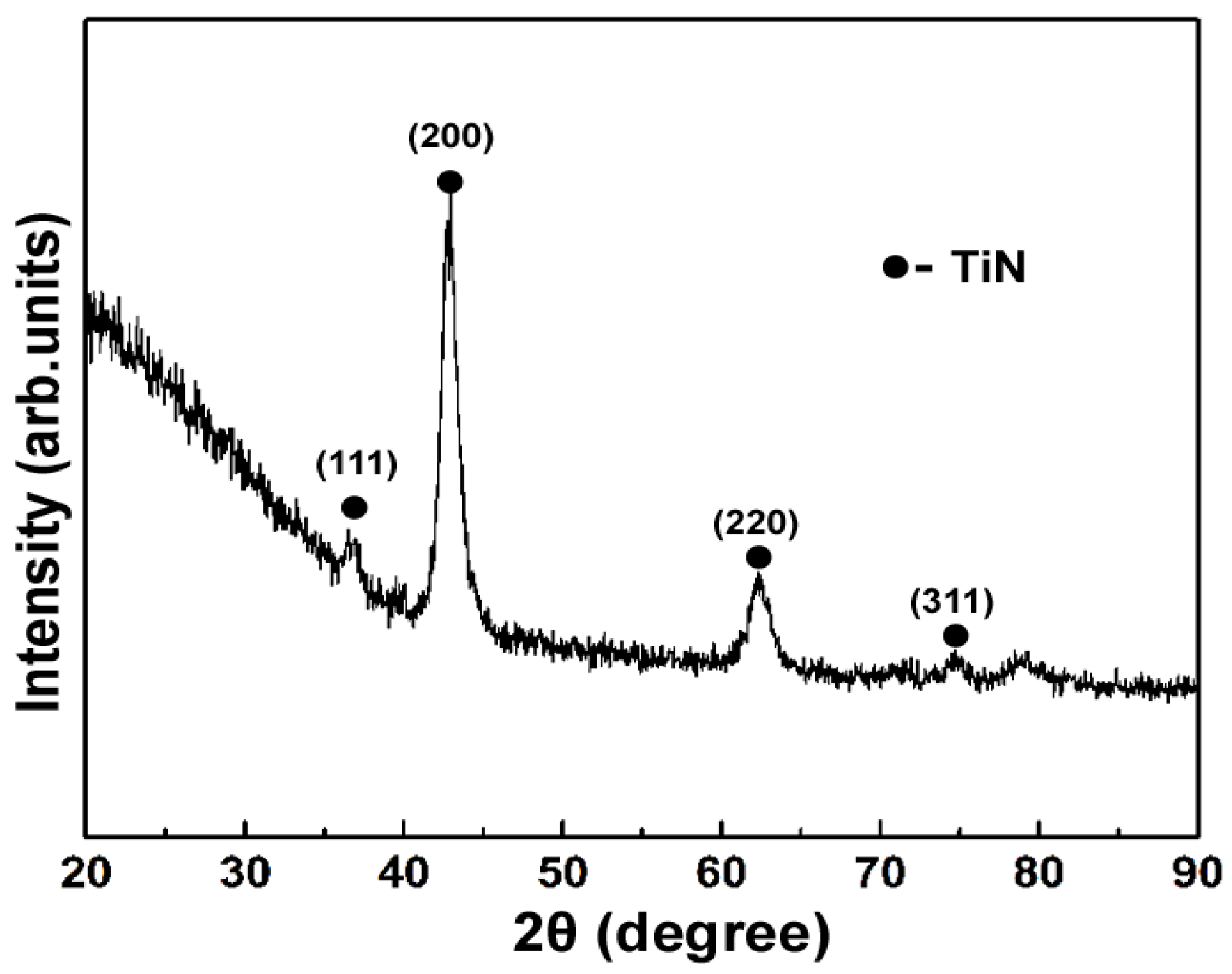

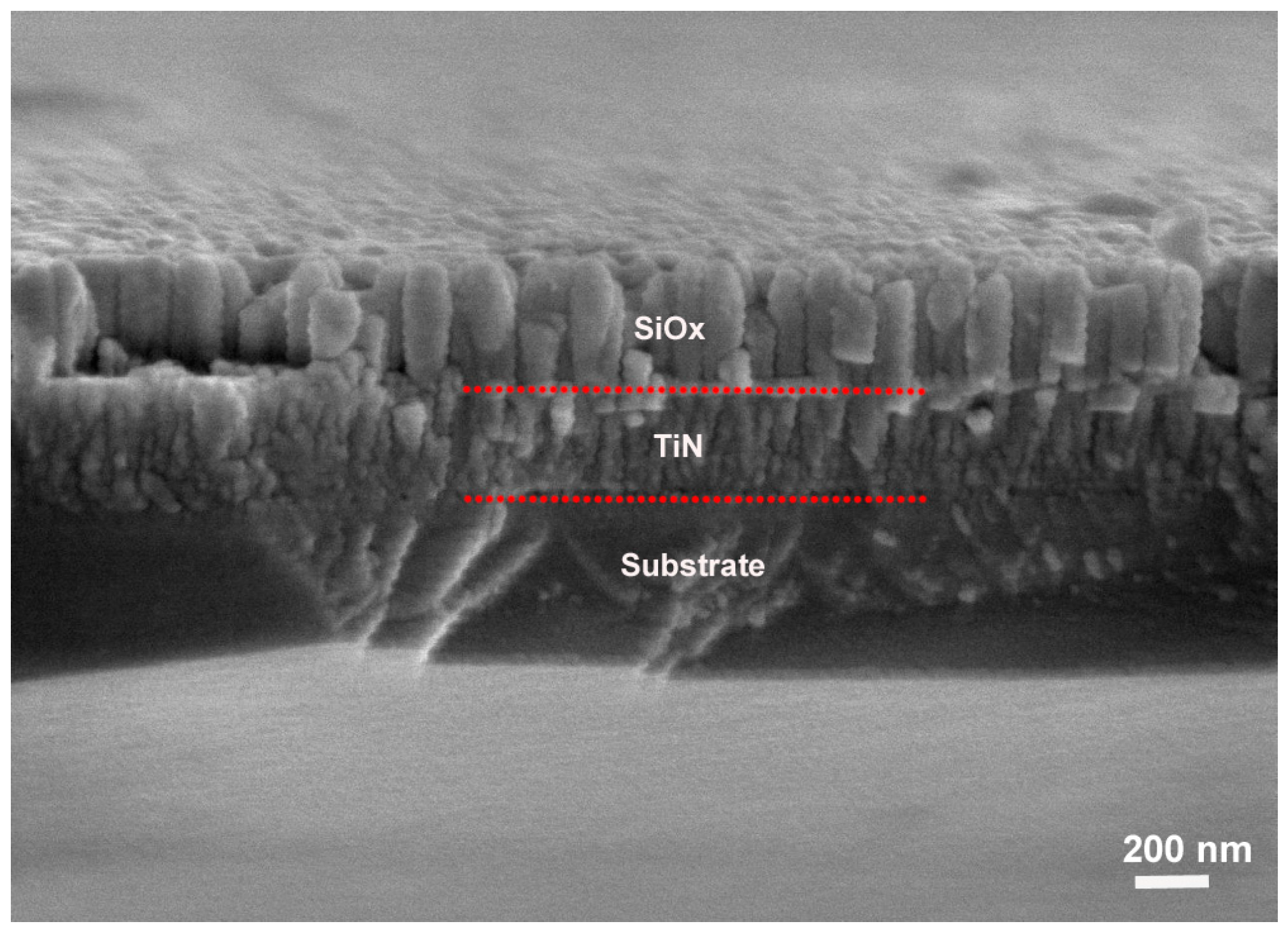
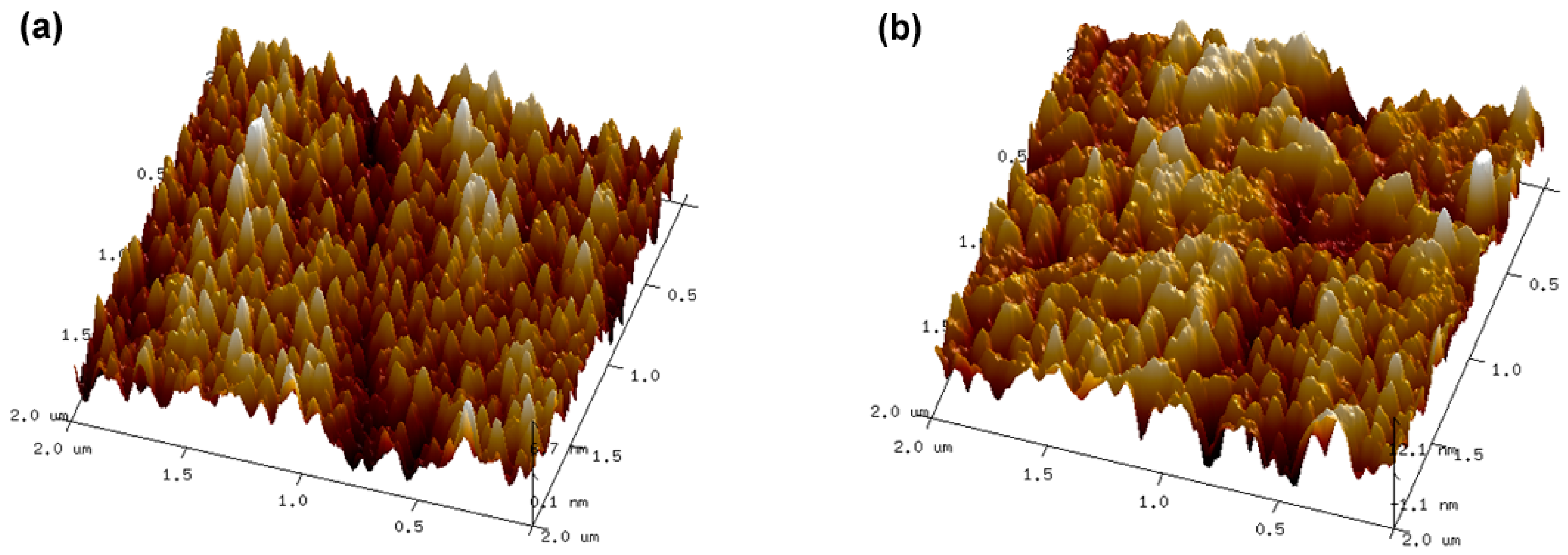
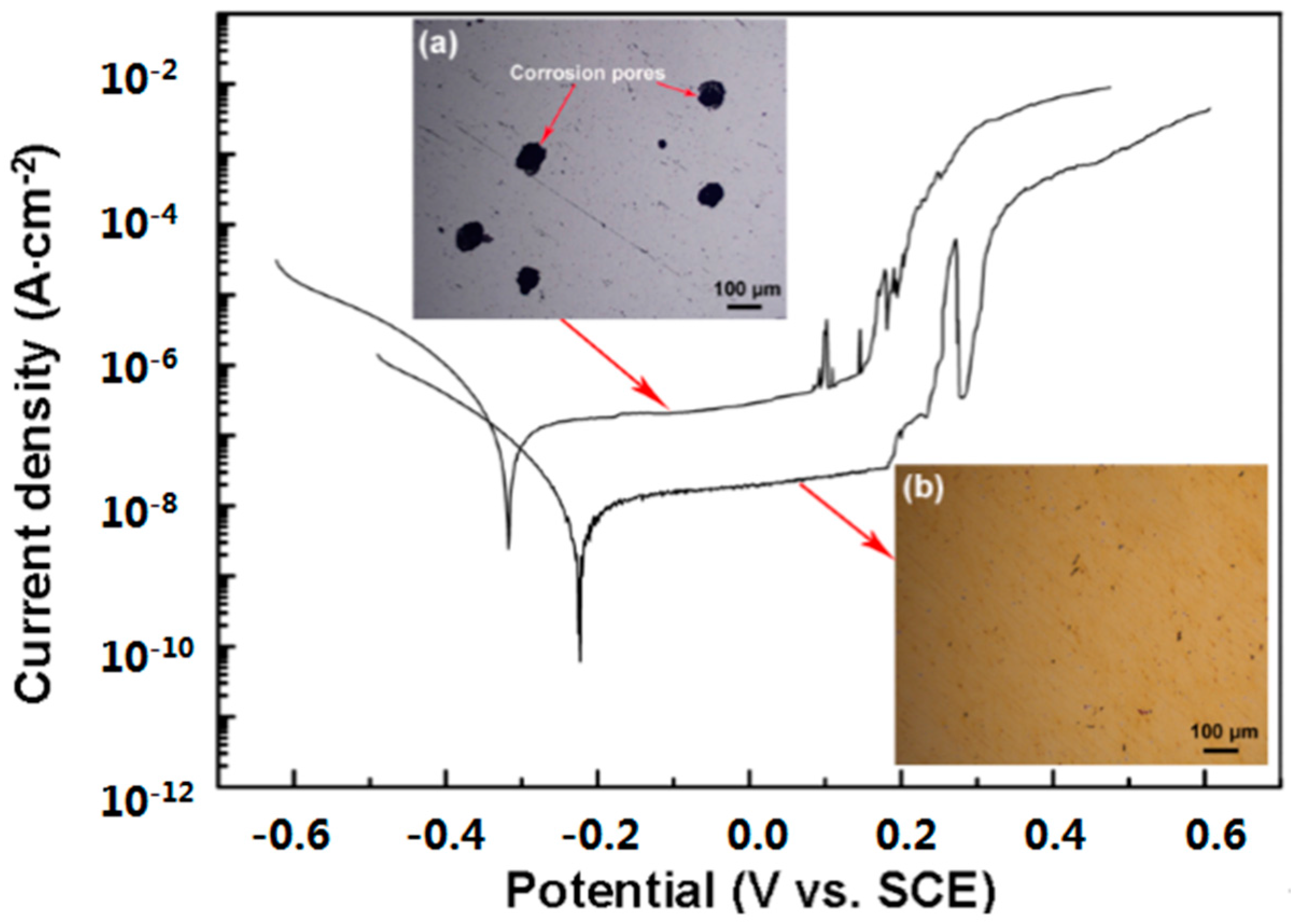
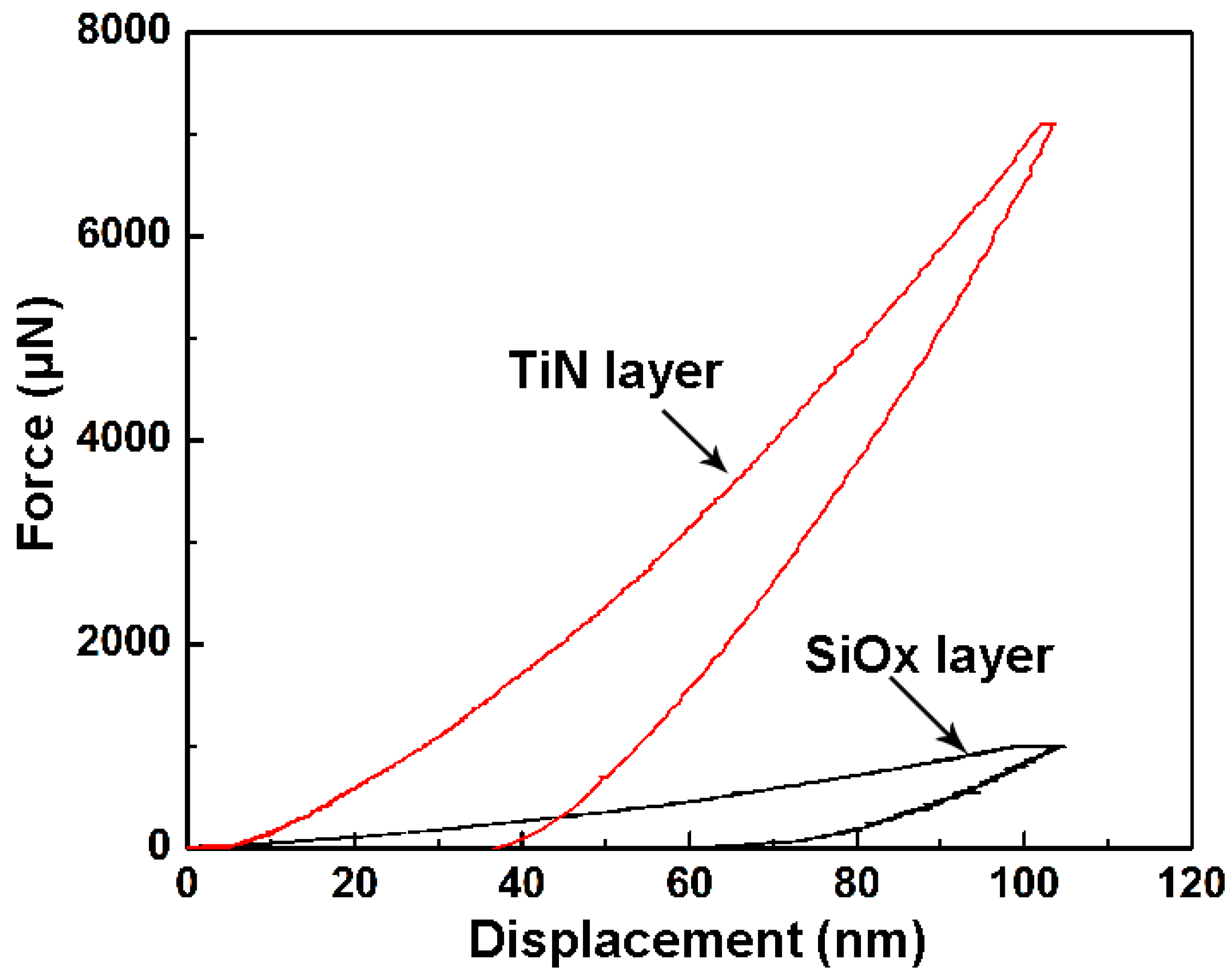
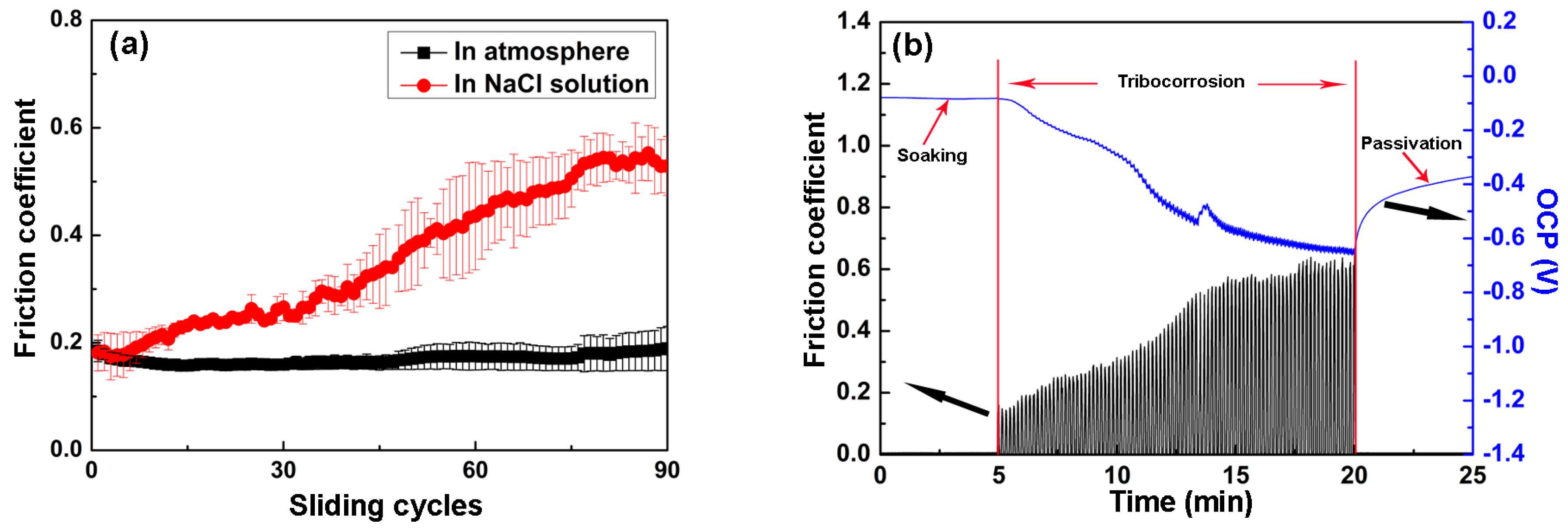
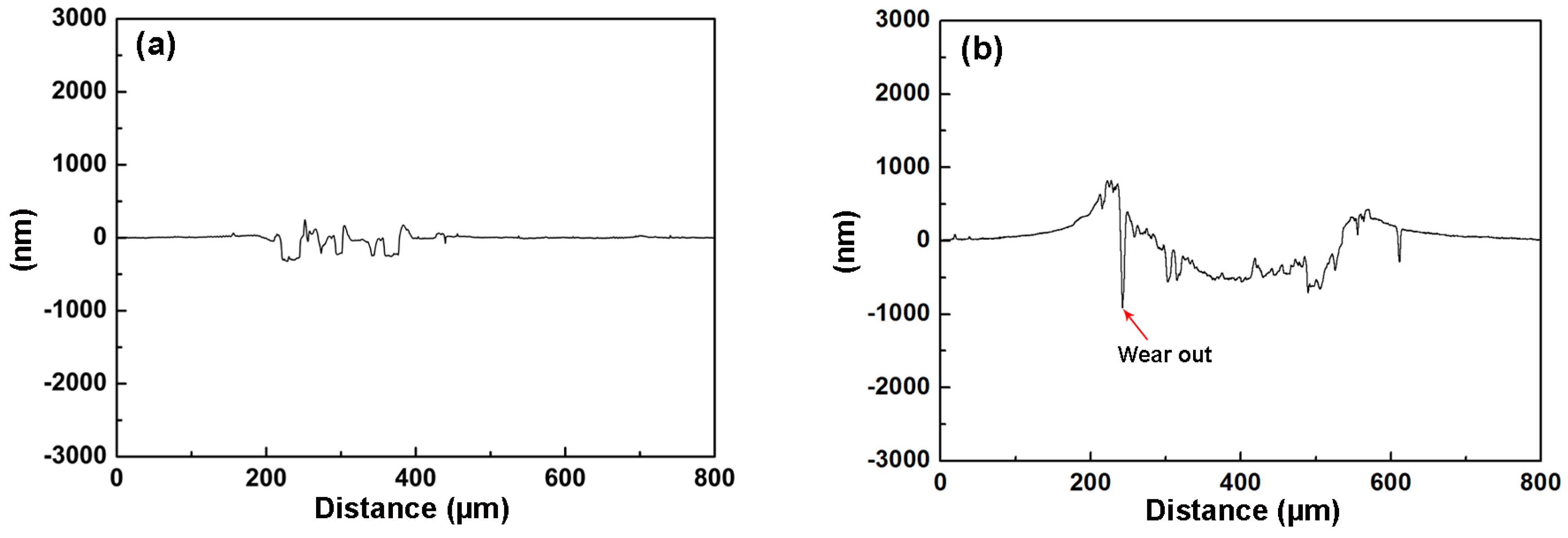
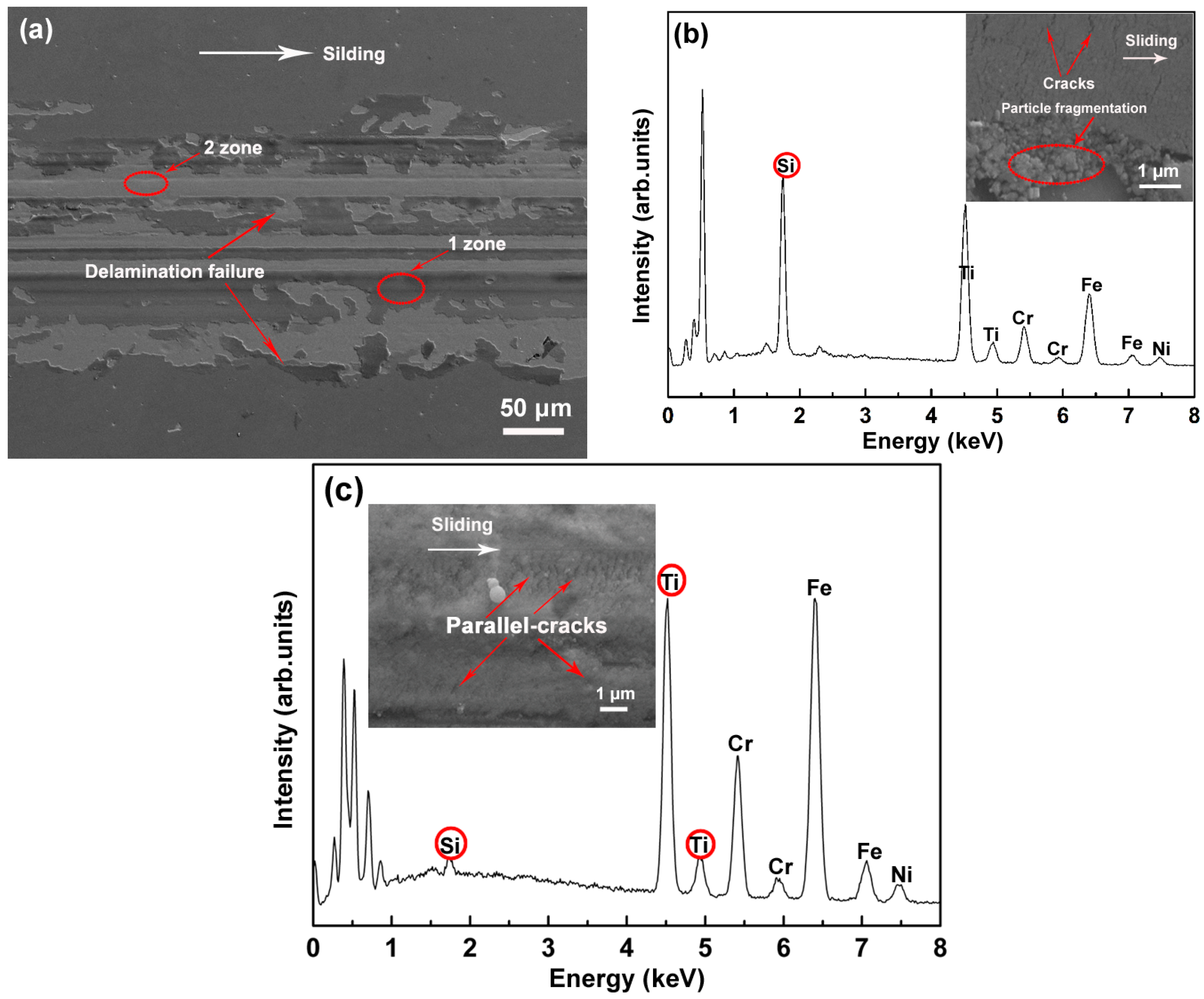
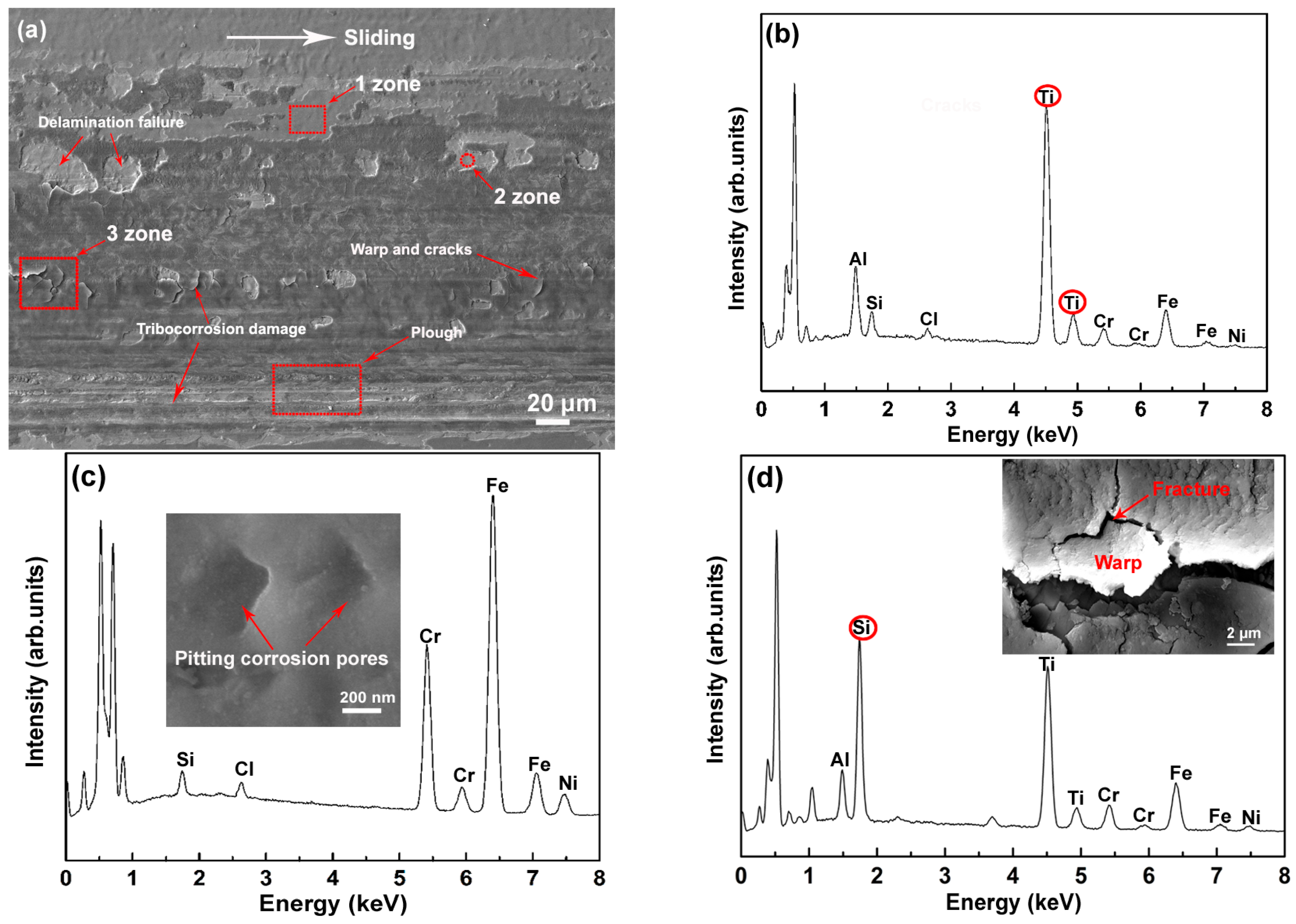

© 2016 by the authors; licensee MDPI, Basel, Switzerland. This article is an open access article distributed under the terms and conditions of the Creative Commons Attribution (CC-BY) license (http://creativecommons.org/licenses/by/4.0/).
Share and Cite
Chen, Q.; Xie, Z.; Chen, T.; Gong, F. Tribocorrosion Failure Mechanism of TiN/SiOx Duplex Coating Deposited on AISI304 Stainless Steel. Materials 2016, 9, 963. https://doi.org/10.3390/ma9120963
Chen Q, Xie Z, Chen T, Gong F. Tribocorrosion Failure Mechanism of TiN/SiOx Duplex Coating Deposited on AISI304 Stainless Steel. Materials. 2016; 9(12):963. https://doi.org/10.3390/ma9120963
Chicago/Turabian StyleChen, Qiang, Zhiwen Xie, Tian Chen, and Feng Gong. 2016. "Tribocorrosion Failure Mechanism of TiN/SiOx Duplex Coating Deposited on AISI304 Stainless Steel" Materials 9, no. 12: 963. https://doi.org/10.3390/ma9120963




